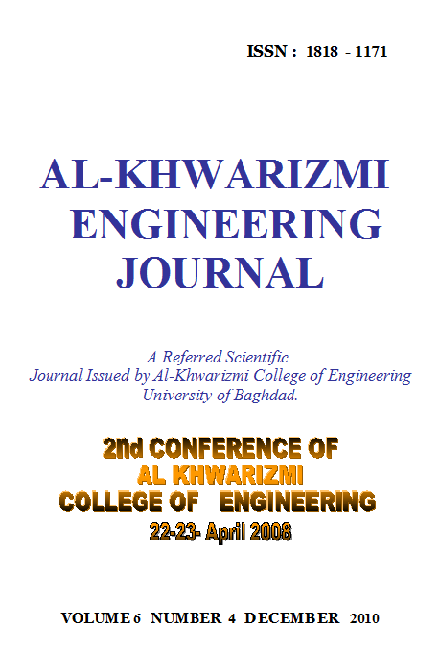Evaluation of Mechanical Properties of Particulate Composites
Abstract
A series of experiments have been taken out to test the validity of the effect of Aluminum hydrate on its interaction with Aluminum during sintering of aluminum metal matrix. The approach has been shown to be valid and several compositions have been fabricated. The alumina hydrate particle size and the amount of alumina hydrate in the composites are also shown to have an influence on the extent of densification.
The densities for all sintered specimens were measured. It was found that density increases as compaction pressure increases, the density decreases as particles size increases. At 400 MPa there is an optimum particles size which is (90-125) µm to reach maximum density and the density decreases as volume fraction increases from 2% to 20%.
The microstructure enhances as compaction pressure increases, agglomeration of alumina hydrate particles increases with increasing of volume fraction and cavities increases especially at low compaction pressure more than at high compaction pressure.
The mechanical properties (compression test and Vickers hardness) of sintered specimens compacted at 100 MPa accomplished for three volume fractions 2%, 10% and 20% and three particles size (45-90) µm, (90-125) µm and (125-150) µm. Young's modulus in compression decreases as volume fraction increases. Also it decreases as particles size increases and Vickers hardness decreases as volume fraction increases. Also decreases as particles size increases.
Downloads
References
[2] M K Surappa, Aluminium matrix composite: challenges and opportunities, sadhana vol. 28, part 1&2 pp. 319-334, India, 2003.
[3] T. W. Clyne, Metal Matrix Composite: Matrices and Processing, Encyclopedia of Materials, 2001.
[4] M. vedula, R. N. Pangborn and R. A. Queeney, Fiber Anisotropic Thermal Expansion and Residual Thermal Stress in a Graphite/Aluminum Composite, Composite vol.19 No.1, 1988.
[5] Anil Kumar Sinha, Powder Metallurgy, Dhanpai Rai & Sons, 1987.
[6] V. K. Manchanda. G. B. S. Narang, Materials and Metallurgy, Khanna publishers, 1995.
[7] ASTM B331-85.
Published
Issue
Section
License
Copyright: Open Access authors retain the copyrights of their papers, and all open access articles are distributed under the terms of the Creative Commons Attribution License, which permits unrestricted use, distribution, and reproduction in any medium, provided that the original work is properly cited. The use of general descriptive names, trade names, trademarks, and so forth in this publication, even if not specifically identified, does not imply that these names are not protected by the relevant laws and regulations. While the advice and information in this journal are believed to be true and accurate on the date of its going to press, neither the authors, the editors, nor the publisher can accept any legal responsibility for any errors or omissions that may be made. The publisher makes no warranty, express or implied, with respect to the material contained herein.












